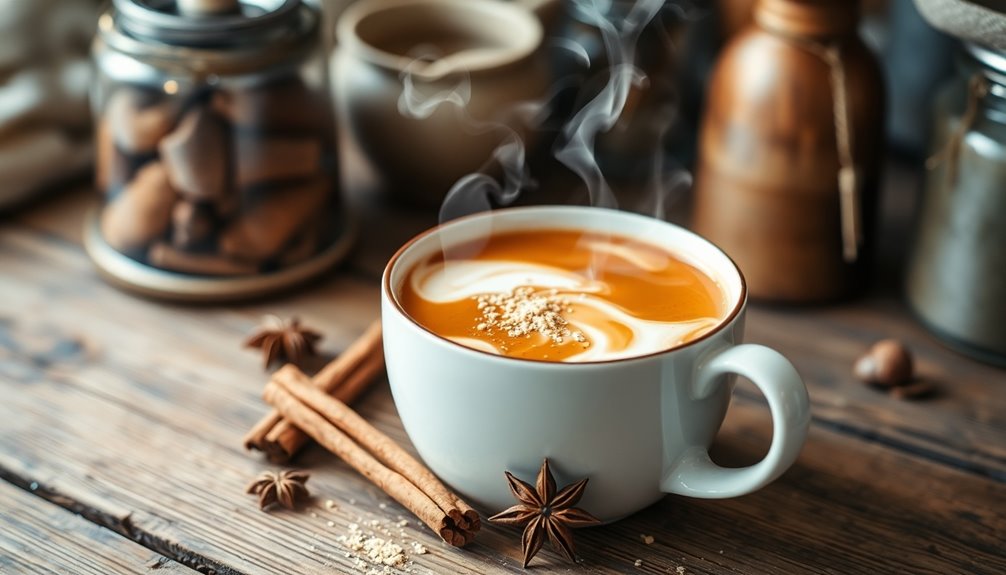To prepare oolong tea at home, start with high-quality loose leaves. Use about 1 tsp per 6 oz of fresh, filtered water for a balanced brew. Rinse the leaves with hot water briefly to enhance flavor. Heat your water to 180°F for lighter oolongs or 200°F for darker ones. Steep for 1 to 5 minutes, tasting every 30 seconds until it reaches your desired strength. After steeping, you can reuse the leaves, simply adding a minute for each subsequent brew. This process will elevate your tea experience, and if you're curious, there's so much more to explore.
Key Takeaways
- Use high-quality loose leaf oolong tea, measuring 1 tsp (2g) per 6 oz of water for optimal flavor extraction.
- Rinse the tea leaves with hot water briefly to enhance flavor and cleanse impurities before brewing.
- Heat filtered or spring water to the appropriate temperature: 180°F for light oolongs and 200°F for dark oolongs.
- Steep the tea for 1-5 minutes, tasting every 30 seconds to achieve your desired strength.
- Reuse tea leaves for multiple infusions, adding an extra minute for each subsequent steeping to explore different flavors.
Understanding Oolong Tea

Oolong tea, a delightful blend between green and black teas, offers a unique flavor experience that’s hard to match. This partially oxidized tea showcases oxidation levels ranging from 10% to 80%, striking a balance between the freshness of green tea and the richness of black tea. The diverse oxidation process contributes to a wide array of flavors, from floral and fruity notes to deeper, toasted undertones. When considering an oolong tea versus green tea comparison, it’s essential to note that green tea maintains a lighter, more delicate profile, while oolong brings a complexity that can be savored over multiple infusions. This makes oolong not only a versatile choice for tea enthusiasts but also an exciting exploration for anyone looking to expand their palate.
When you explore Oolong, you'll find varieties like Bai Ho, with its clean and fruity notes, and Da Hong Pao, known for its earthy, robust flavor.
Primarily cultivated in China and Taiwan, especially in Fujian and Guangdong provinces, Oolong tea benefits from traditional preparation methods, using gaiwans or Yixing teapots to enhance its aroma and taste.
Each oxidation level contributes distinct characteristics, making Oolong a fascinating choice among Chinese teas.
Types of Oolong Tea

When it comes to oolong tea, you'll find a fascinating range of types, primarily categorized as light and dark.
Each type brings unique flavor profiles and aromas, making your choice an exciting part of the brewing experience.
Popular varietals like Tieguanyin and Da Hong Pao showcase the rich diversity within this delightful tea category.
Light and Dark Oolongs
Tea lovers can explore a fascinating range of flavors and aromas within the world of oolong tea, particularly through its light and dark varieties.
Light oolongs, often called green oolongs, are lightly oxidized (10-30%) and deliver floral and fruity notes that are aromatic and invigorating. On the other hand, dark oolongs are oxidized more deeply (60-80%), offering robust, earthy flavors that cater to those who enjoy a stronger tea experience.
When brewing oolong tea, remember that light oolongs brew best at cooler temperatures around 180°F, while dark oolongs require higher temperatures up to 200°F.
Each type brings its unique characteristics to your cup, making it worthwhile to experiment with both!
Popular Varietals Explained
Exploring the diverse world of oolong tea reveals a variety of popular varietals, each with its own distinct flavor profile and characteristics.
Here are some high-quality oolong teas you might want to try:
- Tieguanyin: Floral and creamy with a revitalizing finish.
- Da Hong Pao: Rich, roasted flavors, reminiscent of chocolate and stone fruit.
- Milk Oolong: Buttery and sweet, thanks to its unique processing method.
- Wuyi Oolong: Earthy with mineral undertones, offering a "rocky" essence.
- Bai Ho Oolong: Light and fruity, with a subtle sweetness for a rejuvenating sip.
These varietals showcase the incredible versatility of oolong tea, making it an exciting choice for any tea lover seeking to explore different tea leaves and flavors.
Brewing Essentials

To brew the perfect cup of oolong tea, you need the right tools and ingredients.
Start with a good brewing vessel, like a gaiwan or teapot, and don't forget to use quality water for the best flavor.
Properly measuring your tea leaves is also key to achieving that ideal infusion.
Essential Brewing Equipment
When brewing oolong tea, having the right equipment can make all the difference in achieving the perfect cup. Start with a gaiwan or a dedicated teapot, which allows loose leaf tea to steep most effectively.
You'll also need a strainer, preferably a basket-style infuser, to separate the leaves from the brewed tea effectively. A measuring cup helps you maintain accurate water and tea ratios for consistent results.
While high-quality water is essential, you should choose fresh, filtered, or spring water for the best flavor. Optional items like a decanter can enhance your tea's presentation.
Here's a quick list of essential brewing equipment:
- Gaiwan or teapot
- Basket-style strainer
- Measuring cup
- Fresh spring water
- Decanter (optional)
Water Quality Importance
The quality of water you use plays a significant role in how your oolong tea tastes. High-quality water enhances the brewing process, allowing the delicate flavors of the tea to shine through.
Avoid distilled water, as it has a flat taste that can dull those flavors. Instead, opt for fresh, cold, filtered, or spring water to elevate your tea experience.
Tap water often contains impurities or chlorine, which can negatively impact the taste, so filtering is best. Consider conducting a taste test with different water types to find the one that complements your tea's characteristics.
Proper Leaf Measurement
Getting the right amount of oolong tea leaves is essential for brewing a flavorful cup. For ideal flavor, aim for:
- 1 teaspoon (about 2 grams) of balled leaves per 6 ounces of water
- 2 tablespoons of loose leaf tea for the same amount of water
- Adjust based on leaf shape; rolled leaves need less
- Accurate measurement prevents over-brewing, which can lead to bitterness
- Use high-quality loose leaf tea for better taste
Experiment with the amount of tea to suit your palate.
Remember, proper leaf measurement guarantees you hit the sweet spot in flavor and strength while keeping your steeping times in check.
Enjoy finding your perfect cup!
Preparing Tea Leaves

To prepare your oolong tea leaves effectively, start with 1 teaspoon of balled oolong leaves or 2 tablespoons of loose leaf for every 6 oz (0.17 kg) of water.
Using high-quality loose leaf tea is essential, as it allows for better infusion and flavor release. Make sure your tea leaves are fresh and stored in an airtight container, away from light and moisture, to retain maximum flavor.
Before you brew oolong, rinse the leaves with hot water to prime them for better flavor extraction and remove any residual dust.
If you're using rolled oolong varieties, give the leaves enough space to unfurl fully during steeping, which enhances your overall tasting experience.
Enjoy your perfectly prepared oolong tea!
Preparing Water

After preparing your tea leaves, focus on the water you'll use for brewing. The quality of water considerably impacts the flavor of your oolong tea.
Here are some tips to keep in mind:
- Use high-quality water, ideally filtered or spring water.
- Avoid distilled or tap water, which can alter the tea's taste.
- Heat your boiling water to a temperature between 180°F to 200°F (82°C to 93°C) for ideal extraction.
- Let the boiled water cool for 15-30 seconds before pouring it over the leaves to prevent bitterness.
- Conduct a taste test with different types of water to find what enhances your oolong tea experience best.
Using the right water makes all the difference in your tea's flavor.
Rinse Technique

Rinsing your oolong tea leaves is essential for achieving the best flavor and cleansing away any impurities.
To rinse, simply pour hot water over the leaves, let it steep for a few seconds, and then discard the liquid.
This simple step primes the leaves for a richer, more aromatic brew.
Purpose of Rinsing
While you might be enthusiastic to brew your oolong tea, taking a moment to rinse the leaves can greatly enhance your experience. Rinsing not only cleanses high-quality loose-leaf oolong of dust and impurities but also prepares the leaves for peak flavor extraction.
By pouring hot water over the leaves and discarding the rinse, you reveal the potential of the tea.
- Cleanses leaves of impurities
- Warms the tea leaves
- Initiates essential oil release
- Prepares for a robust flavor profile
- Guarantees a smoother final brew
This simple technique improves the flavor of your oolong, allowing you to enjoy a more vibrant cup.
Rinsing Steps Explained
To properly rinse your oolong tea leaves, start by boiling fresh water and then pour it over the leaves in your brewing vessel.
This rinsing technique cleanses the leaves and preps them for ideal flavor extraction. After pouring, strain the rinse water immediately into a decanter or cup, discarding it, as it isn't meant for consumption.
Rinsing helps open up the leaves, enhancing their ability to release their flavors during the actual brewing process. It's important to keep this step brief—about 10-15 seconds—ensuring the leaves are warmed up for a balanced and full-bodied flavor.
Following this routine will considerably improve your oolong tea experience and steeping time. Enjoy your perfectly brewed cup!
Steeping Process

Once you've gathered your oolong tea leaves and water, the steeping process begins with careful attention to detail.
To brew the perfect cup of oolong, follow these steps:
- Measure 1 teaspoon (about 2 grams) of loose leaves for every 6 to 8 oz of water.
- Heat filtered or spring water to 180°F to 200°F for ideal flavor.
- Rinse the tea leaves briefly with hot water and discard the rinse.
- Steep the tea for 1 to 5 minutes, tasting every 30 seconds to find your ideal strength.
- After your initial brew, reuse the leaves, adding an extra minute for each subsequent steeping to discover new flavors.
Enjoy the rich, evolving taste with each infusion!
Health Benefits

Enjoying a cup of oolong tea doesn't just please your palate; it also offers numerous health benefits worth exploring. This tea is rich in antioxidants, particularly EGCG, which can promote cardiovascular health and lower heart disease risk. Drinking 5-6 cups daily may help reduce the chance of developing type 2 diabetes. Its anti-inflammatory properties enhance blood circulation, decreasing heart attack and blood clot risks. Regular oolong tea consumption can lower LDL cholesterol while boosting HDL levels, contributing to better heart health. Plus, the vitamins and minerals, like vitamin C, support immune health.
| Health Benefit | Explanation |
|---|---|
| Rich in Antioxidants | Fights free radicals and promotes heart health. |
| Supports Diabetes Prevention | May lower the risk of type 2 diabetes. |
| Improves Cholesterol Levels | Lowers LDL and raises HDL cholesterol. |
| Boosts Immune System | Contains vitamins that enhance overall wellness. |
Side Effects

While oolong tea offers various health benefits, it's important to be aware of its potential side effects. If you enjoy this beverage, keep these points in mind:
- Pregnant women should limit intake to 2 cups daily due to caffeine sensitivity.
- Exceeding the recommended caffeine limit of 200mg/day can cause irregular heartbeat and irritability.
- Oolong tea may inhibit calcium absorption, which could affect bone health.
- Some individuals might experience digestive issues like upset stomach from excess consumption.
- Balance your oolong tea intake with your personal caffeine sensitivity to avoid adverse effects.
Enhancing Your Experience

Being aware of oolong tea's potential side effects allows you to savor it more fully.
To enhance your experience, experiment with different oolong varieties like Tieguanyin or Da Hong Pao. Use traditional brewing vessels, such as gaiwans or Yixing teapots, to improve flavor extraction and appreciate the cultural significance.
Incorporate the gong fu tea ceremony method, focusing on water temperatures between 180°F and 200°F, and steeping times of 1 to 5 minutes to elevate your brew. Serve your tea in fine china or glassware to showcase its beautiful colors and clarity.
For an added touch, pair oolong tea with savory dishes or light desserts like dim sum or roasted nuts to complement and amplify its unique flavors.
Frequently Asked Questions
What Is the Best Way to Prepare Oolong Tea?
To prepare oolong tea, start by measuring 1 teaspoon of balled leaves or 2 tablespoons of loose leaf for every 6 oz of water.
Heat your filtered or spring water to between 180°F and 200°F.
Rinse the leaves briefly with hot water, then steep them for 1 to 5 minutes, tasting every 30 seconds.
Enjoy multiple infusions, adjusting the temperature and steep time as needed to uncover different flavors with each brew.
Do I Put Milk in Oolong Tea?
You shouldn't put milk in oolong tea if you want to fully appreciate its delicate flavors.
Milk can overshadow the tea's unique character, making it less enjoyable, especially if you appreciate the subtleties.
Instead, consider using honey as a natural sweetener to enhance the taste without masking its qualities.
If you crave creaminess, try a small amount of honey; it'll give you added sweetness while keeping the delightful essence of oolong intact.
Is It Okay to Drink Oolong Tea Everyday?
Yes, it's perfectly okay to drink oolong tea every day!
In fact, enjoying 5-6 cups can boost your health by lowering the risk of heart disease and type 2 diabetes, thanks to its antioxidants.
You'll appreciate the moderate caffeine content, which offers a gentle energy lift without jitters.
Just remember to limit your intake to about 2 cups if you're pregnant, as high caffeine levels can cause issues.
Enjoy your daily brew!
What Is the Ratio of Oolong Tea to Water?
When brewing oolong tea, the typical ratio is 1 teaspoon of dry loose leaf tea for every 6 ounces of water.
If you're using larger leaves, consider increasing it to 2 tablespoons for a stronger flavor.
Remember, adjusting the amount can enhance or soften the taste, so feel free to experiment.
Lighter oolongs usually need less tea, while darker varieties benefit from a fuller dosage to bring out their rich flavors.
Conclusion
In the world of tea, oolong is like a dance between black and green, offering a unique experience with every sip. By mastering the brewing essentials and understanding the nuances of this delightful tea, you're not just making a drink; you're creating a moment of tranquility. So, whether you're savoring its rich flavors or reaping its health benefits, enjoy the journey. With each cup, you'll find a little slice of peace in your bustling day.










